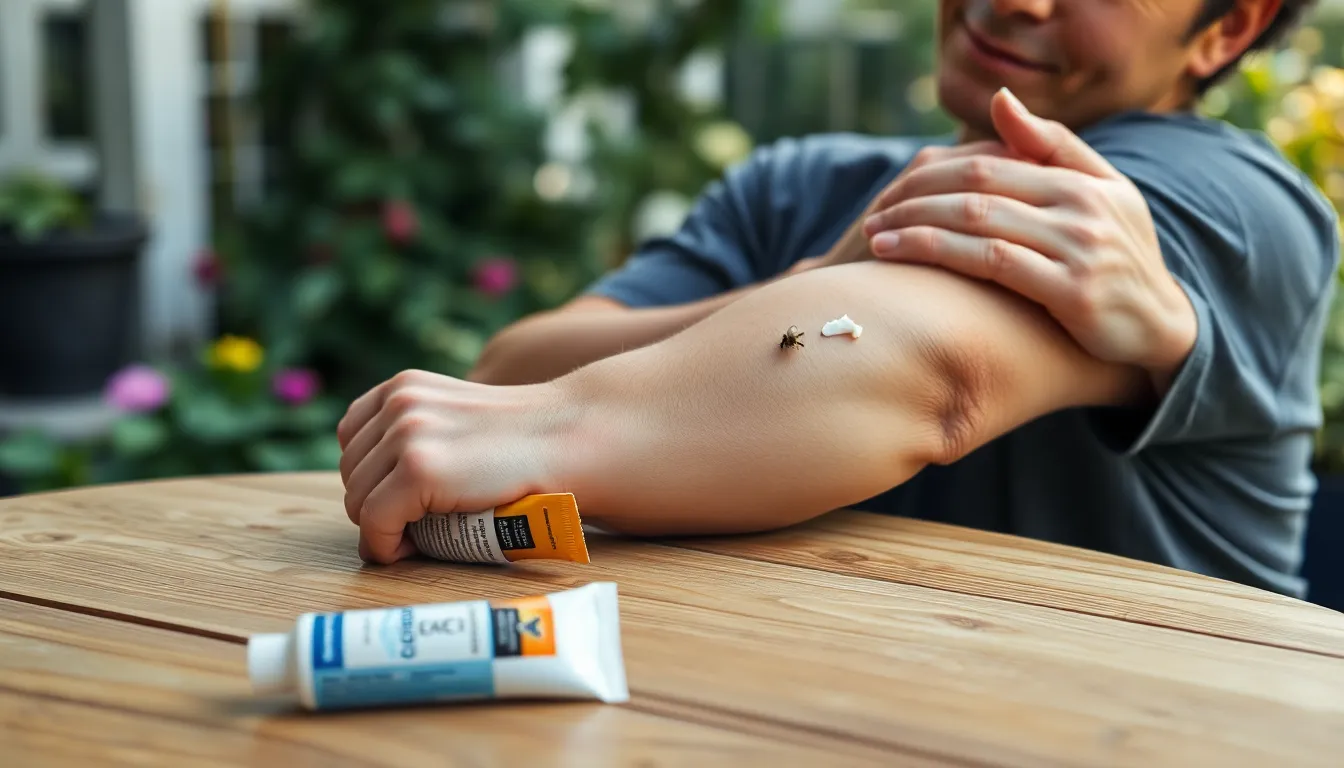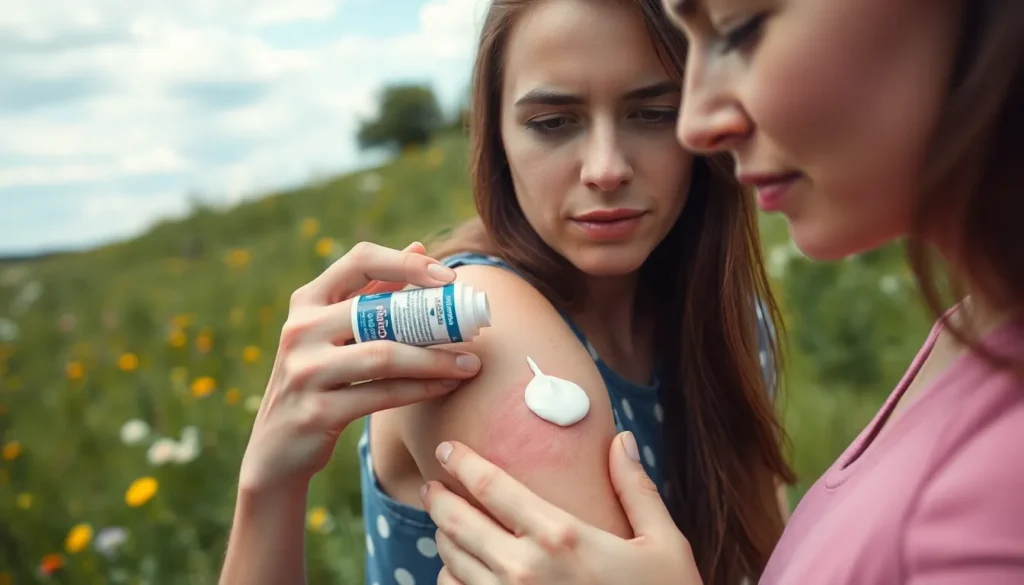Bee stings can turn a pleasant day outdoors into a painful experience in seconds. The immediate pain and swelling can be bothersome, but relief is often just a few steps away. Hydrocortisone cream, a popular over-the-counter treatment, offers a soothing solution for those dealing with the aftermath of a bee sting.
This topical steroid works by reducing inflammation and itching, making it an ideal choice for alleviating discomfort. Understanding how to effectively use hydrocortisone cream can help individuals manage bee sting reactions more efficiently. With the right knowledge, it’s possible to get back to enjoying the great outdoors without the lingering effects of a bee sting.
Table of Contents
ToggleOverview of Bee Stings
Bee stings can cause significant discomfort and irritation. Understanding the symptoms and potential reactions helps in managing the effects of a sting effectively.
Common Symptoms
Bee stings typically lead to immediate pain, redness, and swelling at the sting site. Other symptoms include:
- Itching: A common reaction that can intensify over time.
- Heat: Warmth around the sting area occurs as blood flow increases.
- Bump Formation: A raised welt often forms in response to the sting.
In some cases, additional symptoms such as dizziness or nausea may appear, indicating a more serious response.
Risks and Reactions
Bee stings pose various risks, particularly for individuals allergic to bee venom. Potential reactions include:
- Anaphylaxis: A severe, life-threatening allergic reaction that requires immediate medical attention.
- Localized Swelling: Swelling can extend beyond the sting site, affecting larger areas.
- Skin Infections: Bacterial infections can develop if the sting area is not kept clean.
Awareness of these risks enables prompt action to address both minor and severe reactions effectively.
Hydrocortisone Cream

Hydrocortisone cream serves as an effective treatment option for inflammation and itching caused by bee stings. This over-the-counter topical steroid provides quick relief for discomfort associated with insect bites.
What Is Hydrocortisone Cream?
Hydrocortisone cream is a low-strength topical corticosteroid commonly used to reduce inflammation and relieve itching in various skin conditions. It contains hydrocortisone, which is a synthetic version of cortisol, a hormone produced by the adrenal glands. This cream is readily available and often used for minor skin irritations, allergic reactions, and insect bites, including bee stings.
How It Works
Hydrocortisone cream works by inhibiting the body’s inflammatory response. It decreases the production of inflammatory chemicals at the site of application. This action reduces swelling, redness, and itching, providing rapid relief to those affected by bee stings. Applying the cream directly to the sting site promotes absorption into the skin, ensuring effective management of symptoms. For optimal results, gently rub a small amount onto the affected area up to four times daily, avoiding excessive use.
Effectiveness of Hydrocortisone Cream for Bee Stings
Hydrocortisone cream effectively alleviates the discomfort of bee stings. Its anti-inflammatory properties target swelling and itching, offering significant relief.
Benefits
- Reduces Inflammation: Hydrocortisone cream targets inflammation at the sting site, minimizing redness and swelling.
- Alleviates Itching: It alleviates itching, making it easier for individuals to avoid scratching, which could lead to irritation or infection.
- Rapid Action: Its fast-acting formulation provides quick relief, allowing individuals to return to outdoor activities sooner.
- Ease of Use: The cream’s topical application makes it simple to use, requiring no prescription for access.
Limitations
- Mild Reactions Only: Hydrocortisone cream suits minor reactions, providing limited effectiveness for severe allergic responses or anaphylaxis.
- Temporary Relief: The effects are temporary, requiring reapplication for sustained relief. Overuse can lead to skin thinning.
- Potential Side Effects: Some individuals may experience side effects such as burning or irritation at the application site.
- Not for Infected Wounds: It should not be applied on open or infected skin, potentially complicating treatment for more severe reactions.
Application and Dosage
Proper application of hydrocortisone cream ensures maximum effectiveness against bee sting discomfort. Following correct guidelines aids in symptom relief while maintaining safety.
How to Apply
- Clean the Area: Wash the sting site gently with soap and water to remove dirt and debris.
- Dry the Skin: Pat the area dry with a clean towel to avoid irritation.
- Apply Cream: Use a clean finger or cotton swab to apply a thin layer of hydrocortisone cream directly to the sting site.
- Rub In Gently: Rub the cream into the skin gently until it’s absorbed.
- Frequency: Repeat this process up to four times daily as needed for symptom relief.
Safety Precautions
- Avoid Broken Skin: Do not apply hydrocortisone cream to open or infected wounds, which can complicate healing.
- Follow Dosage Instructions: Adhere to the recommended dosages to prevent skin irritation or other side effects.
- Monitor Symptoms: Observe for worsening conditions, such as increased swelling or signs of an allergic reaction, and seek medical help if necessary.
- Use Sparingly: Limit use to a short duration to minimize the potential for skin thinning or adverse effects.
- Consult Healthcare Providers: Discuss with a doctor before use for those with pre-existing skin conditions or sensitivities.
Alternatives to Hydrocortisone Cream
Several alternatives to hydrocortisone cream provide relief from discomfort caused by bee stings. Home remedies and over-the-counter options can effectively alleviate symptoms such as itching and swelling.
Home Remedies
Home remedies offer natural solutions for soothing bee sting reactions. Popular remedies include:
- Cold Compress: Applying a cold compress for 10-15 minutes reduces swelling and numbs pain, providing immediate comfort.
- Baking Soda Paste: Mixing baking soda with water to create a paste and applying it to the sting site may neutralize toxins and alleviate itching.
- Aloe Vera Gel: Aloe vera possesses anti-inflammatory properties that promote healing and offer cool relief when applied to the sting area.
- Honey: Smearing honey on the affected area offers soothing properties and may help prevent infection due to its natural antibacterial qualities.
- Apple Cider Vinegar: Dabbing diluted apple cider vinegar on the sting site can reduce pain and itching by neutralizing venom.
Over-the-Counter Options
Over-the-counter alternatives complement hydrocortisone cream effectively. These options include:
- Antihistamines: Medications such as diphenhydramine (Benadryl) help reduce itching and swelling by blocking histamine release in allergic reactions.
- Topical Analgesics: Products like benzocaine provide pain relief by numbing the skin at the sting site.
- Calamine Lotion: Calamine lotion relieves itching and discomfort while also providing a cooling effect.
- Other Topical Steroids: Stronger topical steroids, like triamcinolone, may offer alternatives for more severe irritation.
These alternatives offer immediate relief and help manage symptoms for individuals experiencing discomfort following a bee sting.
Hydrocortisone cream serves as a valuable tool for managing the discomfort of bee stings. Its anti-inflammatory properties provide quick relief from itching and swelling, allowing individuals to enjoy outdoor activities without prolonged discomfort.
While it’s effective for mild reactions, awareness of potential side effects and the need for reapplication is crucial. Using the cream correctly enhances its benefits, ensuring maximum relief.
For those seeking alternatives, various home remedies and over-the-counter options can complement hydrocortisone cream, offering additional relief. Staying informed about treatment options and safety precautions empowers individuals to handle bee stings confidently.





